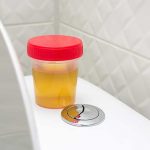- Half-Life Of Codeine
- Drug Tests & Detection Times For Codeine
- Urine Tests
- Saliva Tests
- Blood Tests
- Hair Tests
On average, codeine stays in your system for around 15 hours. Drug tests can detect recent codeine use for longer, including up to 90 days after the last use.
Codeine is a schedule II controlled substance under U.S. federal law. It is available as a prescription drug for pain relief, but also has potential for drug abuse. Drug tests can help medical professionals assess whether you can benefit from substance abuse treatment.
Half-Life Of Codeine
Half-life is the length of time it takes for a drug to decrease to half of its maximum concentration after it is ingested. The half-life of codeine is approximately 3 hours on average.
Between 0 and 3 hours, drowsiness, constipation, and other side effects of codeine may be strong. After 5 half-life cycles, most substances are entirely eliminated from the bloodstream. Codeine takes around 15 hours to be eliminated from the bloodstream through the urine.
How long codeine stays in your system can vary, depending on factors like the frequency of use, taking higher doses of codeine, and mixing codeine with other drugs.
Drug Tests & Detection Times For Codeine
Opioid drug tests may test for morphine. Morphine is a metabolite of codeine, meaning codeine is broken down into morphine by the body. It is also a metabolite of heroin, hydrocodone, oxycodone, and many other opioids.
A positive test for morphine may be a sign of recent codeine, heroin, hydrocodone, or oxycodone use, along with many other opiates.
Urine Tests
Urine tests can detect codeine and morphine metabolites up to 3 days after the last dose.
Urine samples may be a part of drug testing for employers, healthcare providers, or legal processes. Urine samples tend to be fairly accurate and easy to collect, making them a popular type of drug test.
Saliva Tests
Saliva tests can detect codeine and morphine metabolites for several hours after the last use. A variety of factors can change the amount of time codeine stays in your saliva, such as your eating habits and frequency of tooth cleaning.
Saliva tests may take a cheek swab and test the saliva sample, or ask patients to deposit saliva into a tube. Like urine tests, they can be rapid and convenient, though they may require the tester to abstain from eating beforehand.
Blood Tests
Blood tests can detect codeine metabolites for about 15 hours after the last use, or as long as the drug stays in the bloodstream.
Blood tests are often less convenient and more intensive than urine or saliva tests, and are less common as a result. Blood tests may be done in a hospital setting, especially for a patient presenting with side effects of codeine abuse.
Hair Follicle Tests
Codeine and its metabolites can stay in hair follicles for up to 90 days after the last dose. Metabolites end up in hair follicles through the bloodstream, and stay there as the hair grows out.
Hair tests have the longest detection times of conventional drug testing methods.
Treatment Options For Codeine Addiction
Testing positive for codeine use may lead to a recommendation for addiction treatment. Opioid addiction treatment often starts with a detox program, where the drug is flushed from your body while codeine withdrawal symptoms are managed.
After a successful detox, a substance abuse treatment program can help you recover and increase your chances of long-term sobriety.
Treatment programs for opioids may involve behavioral therapy, medication such as methadone and buprenorphine, and educating on alternatives to codeine use.
Contact Northeast Addictions Treatment Center to find out if our outpatient opioid treatment program works for you or your loved one.
Sources
Written by
Northeast Addition Editorial Team
©2024 Northeast Addition Center | All Rights Reserved
This page does not provide medical advice.




